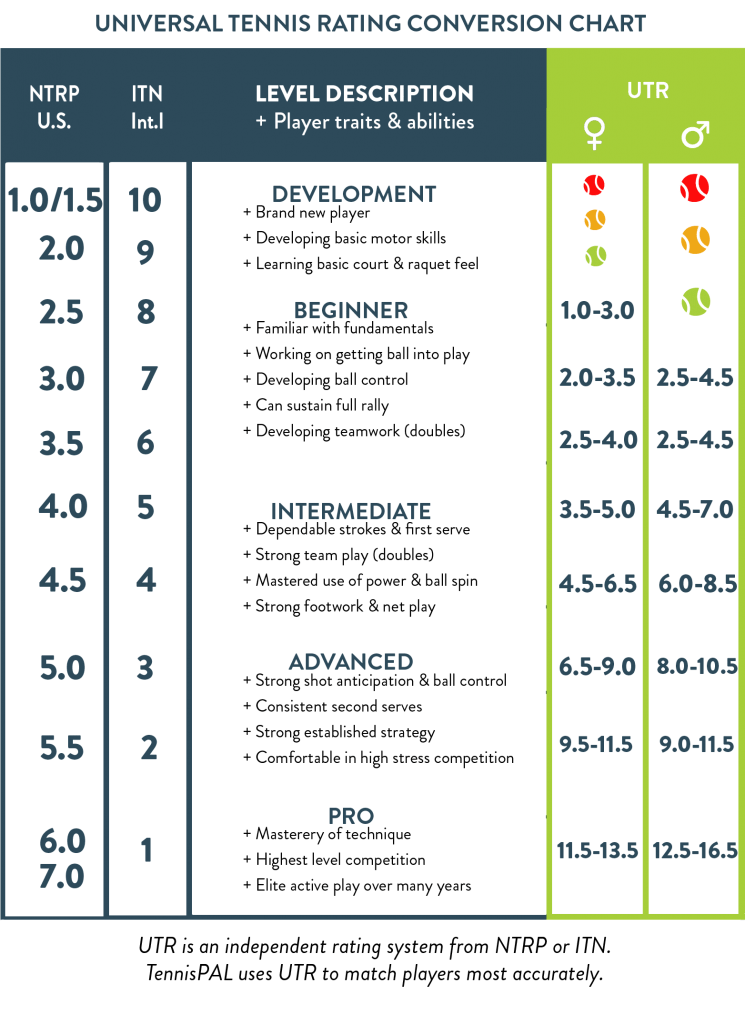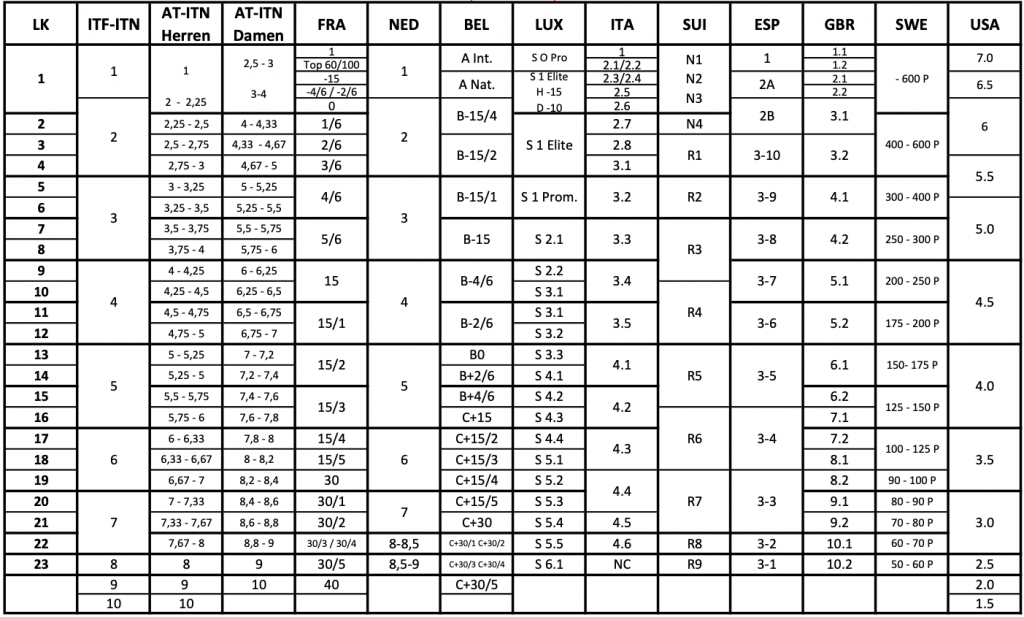Understanding your level of tennis is key to figuring out the right gear for your game. But where do you start?
The playing level is always challenging to describe. Scales like intermediate, club level, and advanced are too broad to describe playing ability adequately. That is why I find the NTRP (national tennis rating program of the USTA) scale useful.
The levels go from 1 to 7, where 1 is a beginner, and 7 is a pro. Below the NTRP scale, you will find conversation tables for your national level and UTR.

The NTRP scale of tennis playing ability
1.0 Just starting to play tennis
1.5 Has limited experience and is still working primarily on getting the ball into play.
2.0 Needs on-court experience. Obvious stroke weaknesses but is familiar with basic positions for singles and doubles play.
2.5 Learning to judge where the ball is going, although court coverage is weak. Can sustain a short rally of slow pace with other players of the same ability.
3.0 Fairly consistent when hitting medium-paced shots but is uncomfortable with all strokes and lacks execution when trying for directional control, depth, or power. The most common doubles formation is one-up and one-back.
3.5 Has improved stroke dependability with directional control on moderate shots but still lacks depth and variety. Starting to exhibit more aggressive net play, has improved court coverage and is developing teamwork in doubles.
4.0 Has dependable strokes, including directional control and depth on both forehand and backhand sides on moderate shots, plus the ability to use lobs, overheads, approach shots and volleys with some success. Occasionally forces errors when serving and teamwork in doubles is evident. Might lose rallies due to impatience.
4.5 Starting to master the use of power and spins and beginning to handle pace, has sound footwork, can control depth of shots, and varies game plan according to opponents. Can hit first serves with power and accuracy and place the second serve. Tends to overhit on difficult shots. Aggressive net play is standard in doubles.
5.0 Good shot anticipation and frequently has an outstanding shot or exceptional consistency around which to base your game. Can successfully execute lobs, drop shots, half volleys and overhead smashes and has good depth and spin on most second serves. Can regularly hit winners, force errors off short balls, and put away volleys.
5.5 Has developed power and/or consistency as a major weapon. Can vary strategies and styles of play in a competitive situation and hit dependable shots in a stressful situation.
6.0 Has obtained a sectional and/or national ranking.
6.5 Has extensive satellite tournament experience.
7.0 Makes a living from tournament prize money.
For the sake of finding a racquet setup, we can lump these scales together into fewer categories:
The Tennisnerd take on the NTRP scale
- Kids and young juniors
- Beginners to intermediate 1-3
- Intermediate to advanced 3.5-5
- Advanced to pro 5.5 – 7
Why? Because there is not a racquet that works for a 3.5 and not a 4.0. And there is not a specific racquet type for beginners and one for intermediate players.
You can make some generalizations about a category or a certain level of players, which will hopefully help guide you forward.
If you are a beginner to intermediate player, your game will most likely benefit from a larger head size and a lighter weight.
You are likely not consistent enough with your technique and footwork to regularly hit the ball in the center of the racquet. Therefore, a smaller head size will make you mishit more often, and a larger head size will allow even some off-center shots to find the other side of the court.
That is why I would recommend any beginner to intermediate player to use at least a 100 sq inch head size. After all, many pros also use larger head sizes. Rafael Nadal is the most famous example. On the other hand, Djokovic, Murray, and Wawrinka all use 95 sq inch head sizes, so for the pros, it depends a lot on their playing style and what they grew up using as juniors. It again shows the personal nature of tennis gear.

